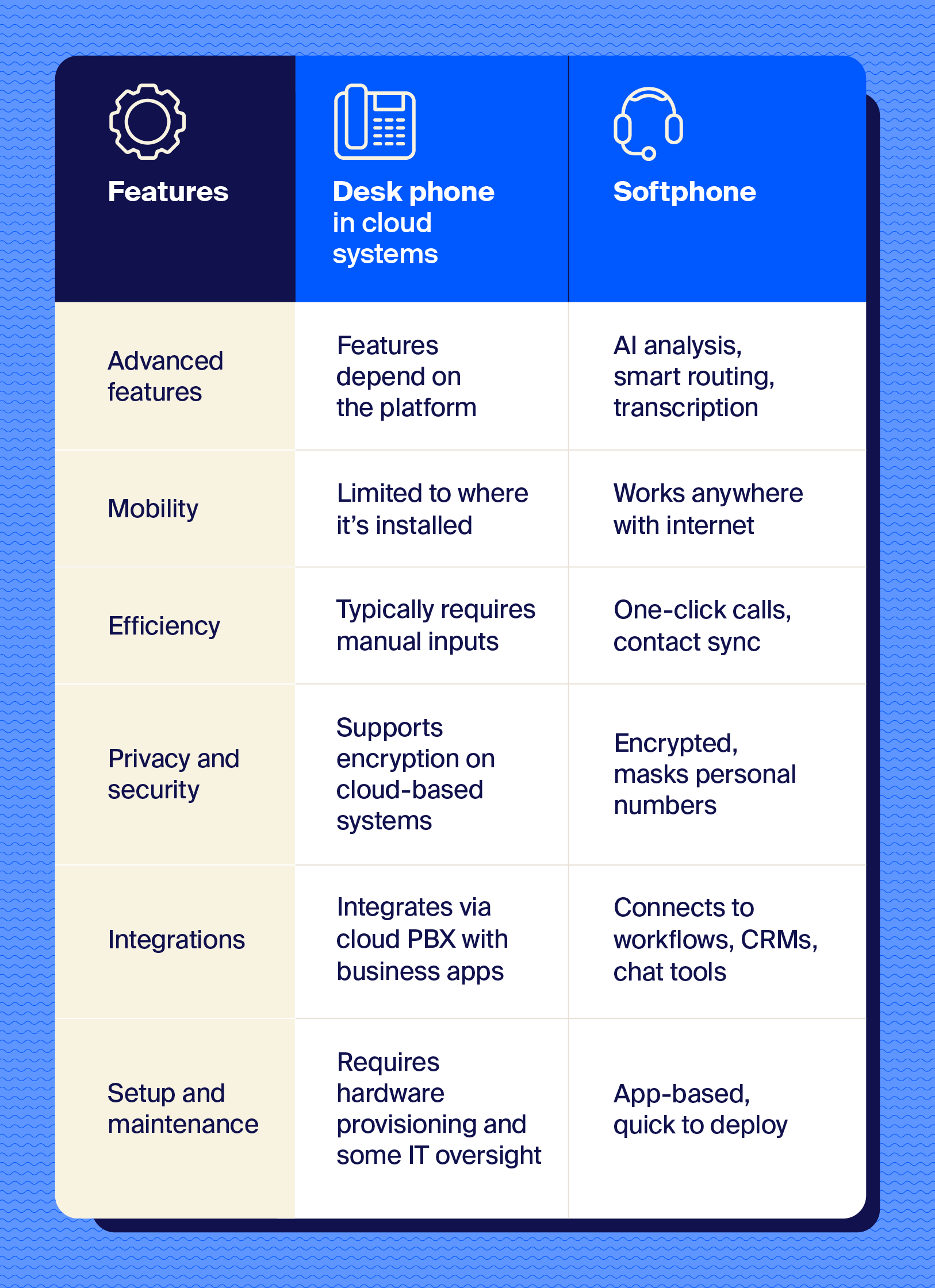
Meet Zoom AI Companion, your new AI assistant!
Boost productivity and team collaboration with Zoom AI Companion, available at no additional cost with eligible paid Zoom plans.
Updated on September 02, 2025
Published on September 02, 2025


As modern workplaces evolve, so do their communication needs. Traditional on-premises phone systems, often reliant on physical desk phones, can hold businesses back with high costs, limited flexibility, and difficult integrations. That’s where softphones come in. As part of a cloud-based VoIP system, softphones offer a flexible, cost-effective solution that supports hybrid teams and scales effortlessly with your business.
Transitioning from physical hardware to an internet-based softphone is cost-effective and scalable (there’s no need to add more space or hardware as you hire additional employees). Plus, you’ll be able to integrate your phone system with other systems, such as your CRM, improving both employee productivity and customer experience.
This article will explain what a softphone is, how it works, the setup process, and why and how you should consider switching to a softphone system.
Simply put, a softphone is a software-based telephone that lets you make and receive calls over the internet. They typically run on voice over internet protocol (VoIP) instead of traditional phone lines.
Unlike a standard physical phone, a softphone exists in a computer (or tablet or smartphone), replicating all the features you expect on a phone, but digitally. Softphones are excellent additions to a cloud contact center or a hybrid work environment.
And if you’re wondering why it’s called a softphone, the term blends software and telephone, leading to softphone.

Softphones use VoIP technology to transmit calls using the internet instead of telephone lines. Users can access these phones from their computer or a mobile device, whether they’re using a desktop, laptop, or tablet (running Mac, Windows, Linux, or mobile operating systems). To get the full functionality, you’ll need internet connectivity, speakers, and a microphone.
Softphones offer the full functionality of traditional desk phones, and often go even further with capabilities that extend beyond basic calling. Here are a few of the most common features of a softphone app:
Setting up a softphone might seem daunting at first, but it’s actually quite easy. Simply follow these basic steps:

While both softphones and desk phones can operate within a modern cloud-based VoIP system like Zoom Phone, softphones provide unique advantages, especially for hybrid teams, remote workers, and businesses looking to scale without investing in additional hardware.
Here, we go over some of the reasons many businesses choose softphones as their go-to communication tool.
Cloud-connected desk phones and softphones support advanced calling features, but softphones often make them more accessible and user-friendly without requiring specialized hardware or admin setup. Common features of cloud-based phone systems include:
Softphones are ideal for hybrid and remote work. They run on laptops and mobile devices, meaning employees can take business calls from anywhere with an internet connection. This flexibility helps with business continuity and supports a mobile workforce without extra hardware.
Within a single app, softphones give users immediate access to contacts, call history, voicemails, and team messaging. Features like one-click dialing and easy call transfers reduce friction, while the software-based setup means teams can onboard faster without IT provisioning physical devices.
Modern softphones can support enterprise-grade security like end-to-end encryption. They also help maintain personal privacy by assigning business phone numbers, keeping employees’ personal numbers protected. While physical desk phones can also be secure on a cloud system, softphones offer flexible privacy controls right from the user interface.
The benefits of using softphones for business are clear, but not all softphone software is equal. Here are some of the most important features to look for when considering phone apps.
How a phone handles missed calls is almost as important as how it handles those you answer. A good softphone system includes basic voicemail features, but look for options like AI-generated transcriptions and voicemail-to-email, as well as advanced AI-first features such as bringing priority voicemails to the top of the list and surfacing tasks from voicemails to help you understand next steps without going through every message.
A softphone that doubles as a contact database helps you avoid scrambling to find important phone numbers. With a built-in directory, you can access customer and team contacts at your fingertips.
We’ve all struggled to figure out how to add others to a phone call. With conference calling features, you can set up multi-person calls without additional hardware or confusing processes.
Avoid monitoring multiple business communication systems by using a softphone with team messaging capabilities. This integrated chat function lets you quickly converse with your team right from your phone software.
Softphones often come with built-in tools to monitor and optimize call quality, helping to provide clear, reliable voice transmission. Some systems include real-time quality alerts and AI-driven diagnostics that flag jitter, latency, or packet loss.
Make it easier to route calls with features that show real-time employee or agent availability, such as online, busy, or away. This is especially valuable in a contact center, where visibility into status helps reduce wait times and improve routing efficiency.
Automatically transcribe calls in real time with built-in AI, making it easy to review conversations, capture key details, and create searchable call records. Transcriptions can also support training, compliance, and follow-up tasks without the need for manual note-taking.
Look for softphone systems that integrate with other important systems and workflows. For example, integrating your phone system with your CRM can improve overall customer care. Connecting your smartphone with virtual agents or AI assistants can slash wait times and improve customer satisfaction.
Softphones bring cost-effectiveness and scalability to modern business phone systems. Whether you’re using these systems in a small office or across a global team, softphones unlock powerful features that go far beyond the limitations of traditional desk phones.
The best softphone options should integrate seamlessly into the rest of your workflow, whether you use a CRM, virtual agents, or anything in between. Zoom Phone and Zoom Contact Center are designed to let you deliver excellent customer care on one platform, helping you exceed customer expectations and boost ROI.
Get started with Zoom Phone today.
Take a look at some frequently asked questions about how softphones work.
VoIP, or Voice over Internet Protocol, is the technology used to transmit voice calls over the internet. A softphone is the software used to make those calls. Put simply, a softphone’s calls run on VoIP technology.
Softphones are not especially hard to install. You just need to download and install the software and follow a quick process to get up and running.
Yes, softphones function over Wi-Fi, as well as any other type of internet connection. For example, a softphone can also run on a mobile data network or a wired internet connection.